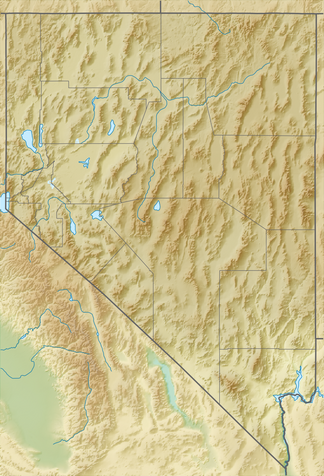Muddy Mountains
| Muddy Mountains | ||
|---|---|---|
|
The Muddy Mountains in Nevada. |
||
| Highest peak | Muddy Peak ( 1643 m ) | |
|
|
||
| Coordinates | 36 ° 24 ′ N , 114 ° 39 ′ W | |
The Muddy Mountains are a mountain range in Clark County in the US state of Nevada . The highest point is Muddy Peak at 1,643 meters. In 2002, the United States Congress declared part of the area to be Muddy Mountain Wilderness . With Wilderness a class of is conservation areas designated, which are basically unaffected by human intervention should be permanently protected from them.
Geography and geology
The Muddy Mountains are about an hour's drive north of Las Vegas , west of Lake Mead and immediately north of the Valley of Fire State Park in Nevada. The Muddy Mountain Wilderness has a size of around 195 km² and includes a large area of the mountain range. 300 million years ago this area was covered by a large sea. The former sea floor today consists of limestone cliffs that rise to a height of 1643 meters. Petrified sand dunes have formed between the mountain peaks, which over time have been washed out into rock galleries and canyons and glow in the colors yellow, orange and red. The unusual sandstone formations of Hidden Valley were exposed by the erosion of the limestone.
Flora and fauna
The entire area lies at an altitude between 510 and 1640 meters, in which the creosote bush or chaparral (Larrea tridentata), black brush (Coleogyne ramosissima), the Joshua palm lily or Joshua tree (Yucca brevifolia), the beavertail cactus (Opuntia basilaris) , the Catclaw Acacia (Acacia greggii) and the Desert Willow (Cuilopsis linearis), as well as the Las Vegas buckwheat (Fagopyrum) and the Las Vegas bear poppy (Arctomecon) can be found. The mammals here are the desert bighorn sheep (Ovis canadensis nelsoni), the kit fox (Vulpes macrotis), the donkey hare or jackrabbit (Lepus californicus) and the coyote (Canis latrans). The reptiles include the California gopher tortoise (Gopherus agassizii), the chuckwalla (Sauromalus), the whiptail (Cnemidophorus) and the striped gecko (Coleonyx variegatus). Among the birds living here belongs rock wren (Salpinctes obsuletus), the phainopepla (Phainopela nitens), the Say's Phoebe (Sayornis saya) and the Red-tailed Hawk (Buteo jamaicensis).
colonization
The Muddy Mountains area was inhabited by humans for at least 4,000 years. Archaeologists have found rock carvings, agave roasters, rock dwellings, worked stones and pottery shards. There are impressive petroglyphs in the Colorock area and in the Hidden Valley, as well as in the Buffington Pockets area.
getting there
The Muddy Mountains are the Bitter Springs Back Country Byway , the North Shore Road of Lake Mead and several roads from the west, including the Colorock Road to reach. Most of the roads mentioned are unpaved gravel roads. From Las Vegas , the Muddy Mountains look like a single mountain range. In fact, only the western highest part of the mountain range is visible, which extends east-west. The mountain range is cut by deep canyons and the southern part contains plains and dry river beds (English wash) that run south.
Individual evidence
- ↑ a b Muddy Mountains Wilderness , accessed August 27, 2013
- ↑ a b Bird and Hike , accessed August 28, 2013

